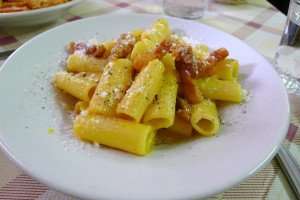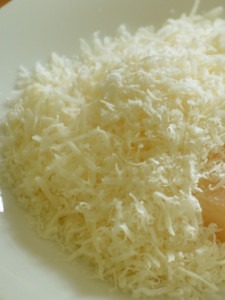Costa Rica's Favorite Meal: The Casado
February 7, 2025
Costa Rica is a fabulous destination for luxury travelers, as well as seniors, couples, and families, not least because of its many excellent dining options.…
Read This Post Carbonara is one of the most famous of Roman pasta dishes, but also one of the most argued about. Even in Italy, there are passionate disagreements about the “true” recipe for carbonara. Should you use guanciale or pancetta? Should you use parmigiano or pecorino? Does it have onion? Whole egg or only the yolks?
Carbonara is one of the most famous of Roman pasta dishes, but also one of the most argued about. Even in Italy, there are passionate disagreements about the “true” recipe for carbonara. Should you use guanciale or pancetta? Should you use parmigiano or pecorino? Does it have onion? Whole egg or only the yolks?
If you head out of Rome and the Lazio region, you’ll find even more variety in the ingredients: cream, butter, garlic, even peas – peas! And modern chefs take it even further, sprucing up the simple dish with the addition of artichokes, seafood, and more.
 In honor of our new Food and Wine Tours in Rome, Italy, we’re going to really dive into what carbonara is and how it should be made.
In honor of our new Food and Wine Tours in Rome, Italy, we’re going to really dive into what carbonara is and how it should be made.
I’ve read (and heard) a variety of stories about how carbonara came into being, but there seems to be little consensus.
There was already a type of pasta made with egg and cheese (“cacio e ova”) in nearby Campagna (and potentially in Lazio and Abruzzo as well). Was this eventually modified with the addition of guanciale, a very typical and characteristic ingredient in Lazio?
 Or was it the advent of the American soldiers during World War II, with their bacon and eggs, that inspired the dish? The fact that carbonara can be made with the typical guanciale or pancetta, which is closer to an American style bacon, might give credence to this theory.
Or was it the advent of the American soldiers during World War II, with their bacon and eggs, that inspired the dish? The fact that carbonara can be made with the typical guanciale or pancetta, which is closer to an American style bacon, might give credence to this theory.
Or if we take a hint from the name, we might follow the hypothesis that it was a quick, easily prepared meal for those working outside near a carbonaro (coal burner). It is made with ingredients that were always on hand.
Learn more about what to eat in Rome.
 There are only a few ingredients in a classic carbonara, and for that reason it is crucial to get high-quality products. In Rome carbonara is usually made with spaghetti or rigatoni, but you can also find it with bucatini or other long pasta shapes.The eggs should be high quality and whole. Roman cuisine is at heart a cucina dei poveri, a “poor person’s” cuisine. Discarding the whites of the egg would be an anathema.
There are only a few ingredients in a classic carbonara, and for that reason it is crucial to get high-quality products. In Rome carbonara is usually made with spaghetti or rigatoni, but you can also find it with bucatini or other long pasta shapes.The eggs should be high quality and whole. Roman cuisine is at heart a cucina dei poveri, a “poor person’s” cuisine. Discarding the whites of the egg would be an anathema.
The cheese is a point of debate: the locally made pecorino romano or parmigiano reggiano? The answer to that will likely depend on where you are in Italy, but also on your own tastes. Pecorino is spicier and saltier than parmigiano, and some prefer that while others prefer the milder parmigiano. When I lived in Rome my friends and I usually used a mix of both.
Finally: the meat. Guanciale or pancetta? Guanciale is cured pork jowl, while pancetta is cured pork belly. Both have a flavor that is mild and sweet. Guanciale can be hard to find in the US, while pancetta is more common. A purist (or a Roman!) would likely say that guanciale needs to be used, but pancetta is an acceptable substitute.
And what about bacon?
Bacon is smoked, while guanciale and pancetta are cured only with salt, pepper, and herbs. So the flavors are wildly different. I’m not saying you can’t use bacon if you have no other choice, but it is definitely not a classic carbonara, and the bacon is pretty much all you will taste.
 Tips for Making the Perfect Carbonara
Tips for Making the Perfect CarbonaraThere are a few rules of thumb that will help you make the perfect carbonara. First, the number of eggs is important. You want the pasta creamy but not overly heavy, and the classic way of determining the number of eggs to use is one whole egg per person, plus one extra.
Second, make sure you beat some of the cheese into the eggs before adding them. It helps the entire dish come together. And bring your eggs to room temperature before beating them. Adding cold eggs to the dish doesn’t give the same consistency.
Thirds–and this is perhaps the most important rule–you do not cook the eggs. If you cook the eggs, even on low heat, they will solidify. If you are not comfortable with uncooked (or barely cooked) eggs, then either buy pasteurized eggs or don’t make carbonara.
This doesn’t mean the egg is raw. Adding it to the hot, freshly drained pasta, along with a ladleful (or so) of hot pasta water will heat the eggs (or temper them) sufficiently.

Serves: 4
Prep time: 5 minutes
Cook time: 12 minutes
Cook method: Boil

1. Set the pasta water to boil with a couple tablespoons of salt added to it. Heat a large, heavy-bottom skillet.
2. Cut the guanciale into a coarse dice (not too finely). Sauté the meat in the hot skillet until the fat has turned liquid and transparent. (You should not need to add oil unless you are using a poor-quality meat that is too lean.) Remove from the heat.
3. Set the pasta to boil according to the package instructions. In the meantime, beat the eggs together with half the cheese and a few twists of black pepper, making sure to beat thoroughly.
4. When the pasta is ready, drain it (being careful to set aside a ladleful of the pasta water), then add it to the skillet. Add the egg/cheese mixture and a bit of water, and mix quickly and thoroughly. You want enough water to make the sauce creamy but not liquid-y.
5. Serve immediately with a sprinkling of the remaining cheese and another bit of pepper.
Chef’s tip: If you’re cooking for a vegetarian, leave out the guanciale. You’ll end up with something very similar to pasta cacio e ova.
 Buon appetito!
Buon appetito!
Are you a carbonara purist, or do you like to experiment? Let us know in the comments!
By Peg Kern
Sign up to receive our newsletter, which includes travel tips, recipes, promotions, and information on our best cooking vacations.
Find more photos, videos, food facts, and travel stories from The International Kitchen on Facebook, Instagram, Pinterest, Twitter, and YouTube.